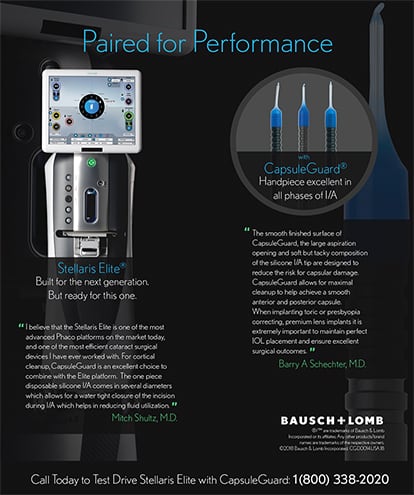As individuals reach ocular maturity, many begin to entertain the possibility of refractive surgery. It is important for optometrists to be on the front end of this discussion with our patients. They are exposed to refractive surgery, whether the topic is raised in the examination room or not.
Laser vision correction has been FDA-approved for more than 20 years. As a result, most people know someone who has had refractive surgery—a friend, family member, coworker. Even if a patient has no personal connection to a refractive surgery patient, advertisements for laser vision correction are prevalent on radio, TV, and social media.
When an optometrist facilitates a surgical referral, it provides an opportunity for collaborative postoperative care and subsequent long-term care of the patient. This article explores some of the reasons optometrists should become involved in collaborative care for their patients who may be interested in refractive surgery.
Be Proactive
An opportunity is missed by ignoring the topic of refractive surgery with your patients. They may be unsure whether they should mention an interest in refractive surgery to their optometrist. Patients who are unsure whether their optometrist is supportive of refractive surgery may decide to pursue surgery elsewhere. As a result, these patients may decide not to return to the practice for their continued long-term eye care.
Proactively bringing up the topic of refractive surgery lets patients know that you are a resource for this type of procedure. Even if a patient is not interested in refractive surgery at the time of an examination, this patient will be more likely to work with his or her optometrist for a recommendation or referral if interest is sparked in the future.
Stay Up Date
Patients want to know their doctor is up to date and knowledgeable about current treatment options. They want to know what’s new. They want to know if there are any new advances that could help their eyes.
Refractive surgery is constantly evolving, and this provides a great opportunity for you to discuss the newest technologies with your patients. No longer is the refractive surgery discussion about only LASIK versus PRK. Treatment options for myopia and astigmatism now include small incision lenticule extraction (SMILE) and toric phakic IOLs.
SMILE, as performed with the VisuMax laser (Carl Zeiss Meditec), is FDA-approved for correction of 1.00 D to 10.00 D of myopia and 0.75 D to 3.00 D of astigmatism. The Visian ICL phakic IOL (Staar Surgical) is now available in both spherical and toric powers, with a range of correction of 3.00 D to 15.00 D of myopia with up to 4.00 D of astigmatism in the spectacle plane, and for reduction of myopia for patients with greater than 15.00 D to 20.00 D of myopia with up to 4.00 D of astigmatism in the spectacle plane. The addition of these technologies to the surgical toolbox now allows more patients to be potential refractive surgery candidates.
Refractive surgery for correction of presbyopia is also evolving. The Kamra corneal inlay (CorneaGen) is available for treatment of presbyopia and can be implanted as a standalone procedure or in combination with LASIK or PRK. Refractive lens exchange for various degrees of myopia, hyperopia, astigmatism, and presbyopia is becoming more sought out with advances in IOL technology. A lens exchange procedure with a multifocal, accommodating, or extended depth of focus IOL can now provide patients with great distance vision and improved intermediate and near vision with less dependence on glasses than would be the case with a traditional monofocal IOL.
Contact Lens Trials
Discussion of surgical technologies often leads to a discussion about new optical technologies, especially contact lenses. The optometrist can be a critical voice in helping patients decide whether refractive surgery is the right choice for them. In the presurgical period, patients may benefit from a contact lens trial.
For example, at his comprehensive eye exam, a 42-year-old myopic patient with -2.00 D myopia in both eyes is questioning whether he would be a good candidate for refractive surgery. Currently, he takes off his glasses to read, but he wants improved uncorrected distance vision. This patient would likely benefit from first trialing some distance and/or monovision contact lenses to determine if he should pursue a surgical correction or continue with occasional glasses and potentially long-term contact lens wear.
A discussion of surgical correction of presbyopia for a patient not yet fully ready to pursue surgery may be a springboard for the patient to trial monovision or multifocal contact lenses for the first time. If you establish yourself as a resource for information about the latest technologies, you can help patients feel confident in your recommendations for surgical and nonsurgical technologies.
Collaborative Care
A patient undergoing refractive surgery gives his or her optometrist a great opportunity to participate in collaborative care. When you provide perioperative care for a refractive surgery patient, you can help the patient understand the procedures under discussion and ensure continuity of care with his or her primary optometrist postoperatively.
When the patient returns for postoperative care, it solidifies your long-term relationship with him or her. These patients will continue to need regular ocular health examinations. As they return, they can benefit from other services and products provided by your office as their eyes grow and change.
Refractive surgery is an exciting event in a patient’s life. These patients tend to be happy to talk about their experiences and results. These are the kinds of patients you want in your clinic and waiting room, sharing their positive experiences. They often generate referrals of friends, family members, coworkers, or acquaintances who have been considering a surgical procedure. If the collaborative care model has worked smoothly for the original patient, their referred patients often want to have the same structure for their care.
People who fit into the refractive surgery demographic tend to be some of the most active on social media. Many patients will post online about their refractive surgery experience or “check in” to your office when they come for postoperative care. A positive social media review about their comanagement experience around the time of refractive surgery can help show to the public the broad scope of care offered at your optometric clinic.
Get Involved
Optometrists should be well versed in the details of refractive surgery and they should also be comfortable talking about it. Optometric care has expanded to significantly more than simply providing refractions, glasses, and contact lenses. The ability to be a source for information and to provide high quality perioperative care for patients seeking refractive surgery allows the optometrist to provide long-term, full-spectrum eye care for his or her patients.






